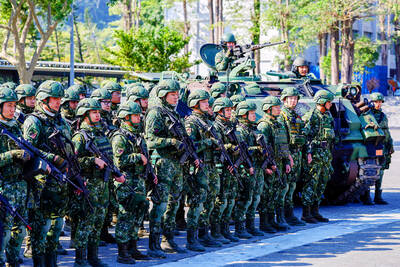Navy Command Headquarters yesterday said that the nation’s warships normally do not use the Automatic Identification System (AIS), except under exceptional conditions, adding that the nation’s newly commissioned Panshih (磐石) supply vessel has now turned off its AIS.
Navy officials made the remarks in response to a port official who said that it is worrying for the nation’s maritime security that ship captains are not aware of the dangers of their vessels’ positions being exposed when conducting missions at sea.
The official, who had retired from the navy and declined to be named, said that he was able to daily follow the nearshore voyage of the Panshih, which sailed from Zuoying Naval Base for the coastal waters around Kaohsiung.
He said he was able to track the AOE 532 Panshih, a fast combat support ship displacing 20,000 tonnes, because it was using AIS, which has an electronic signal to help identify and locate vessels, which allows other ships and port authorities to navigate and regulate marine traffic to avoid collisions.
Due to international maritime conventions, AIS must be installed aboard vessels that travel into international waters with a gross tonnage of 300 tonnes or more, and all passenger ships regardless of size.
According to naval warfare experts, although warships are exempt from such requirements, many do install AIS for use when navigating busy sea lanes and when near a commercial port, but ship captains can switch to a “signal receiving mode only” to avoid exposing their position.
The official said that the Panshih can easily be tracked by the public via the AIS Web site, adding: “This indicates that either the ship’s captain does not understand the need to avoid detection by enemy forces, or there are problems with the navy’s procurement of AIS equipment.”
The navy said that as it took delivery of the Panshih in January, it is still under warranty, and all onboard equipment and electronic systems are being tested to ensure their proper operation.
In other developments, Premier Mao Chi-kuo (毛治國) yesterday had to respond to media reports that alleged the Kidd-class destroyer Tsoying (左營) was used as a “sport boat” in May, when the captain of the destroyer purportedly allowed a petty officer to fish from its deck, from where he caught a large marlin.
Mao said a clear line should be drawn between duty and leisure when onboard warships at sea.
“If they are undertaking training missions, then officers should ensure that discipline and navy regulations are observed,” he said.
Minister of National Defense Kao Kuang-chi (高廣圻) said that whether regardless of whether a vessel is training or participating in exercises, completing missions should be the top priority, but added he would request that naval officials ascertain what had taken place.
However, netizens mostly supported the officers, as some said there are no regulations forbidding servicemen on warships from recreational fishing in their spare time, and others posted photographs of sailors aboard US warships fishing when off duty.
Additional reporting by CNA

UNILATERAL MOVES: Officials have raised concerns that Beijing could try to exert economic control over Kinmen in a key development plan next year The Civil Aviation Administration (CAA) yesterday said that China has so far failed to provide any information about a new airport expected to open next year that is less than 10km from a Taiwanese airport, raising flight safety concerns. Xiamen Xiangan International Airport is only about 3km at its closest point from the islands in Kinmen County — the scene of on-off fighting during the Cold War — and construction work can be seen and heard clearly from the Taiwan side. In a written statement sent to Reuters, the CAA said that airports close to each other need detailed advanced

Tropical Storm Fung-Wong would likely strengthen into a typhoon later today as it continues moving westward across the Pacific before heading in Taiwan’s direction next week, the Central Weather Administration (CWA) said. As of 8am, Fung-Wong was about 2,190km east-southeast of Cape Oluanpi (鵝鑾鼻), Taiwan’s southernmost point, moving westward at 25kph and possibly accelerating to 31kph, CWA data showed. The tropical storm is currently over waters east of the Philippines and still far from Taiwan, CWA forecaster Tseng Chao-cheng (曾昭誠) said, adding that it could likely strengthen into a typhoon later in the day. It is forecast to reach the South China Sea

Almost a quarter of volunteer soldiers who signed up from 2021 to last year have sought early discharge, the Legislative Yuan’s Budget Center said in a report. The report said that 12,884 of 52,674 people who volunteered in the period had sought an early exit from the military, returning NT$895.96 million (US$28.86 million) to the government. In 2021, there was a 105.34 percent rise in the volunteer recruitment rate, but the number has steadily declined since then, missing recruitment targets, the Chinese-language United Daily News said, citing the report. In 2021, only 521 volunteers dropped out of the military, the report said, citing

WEATHER Typhoon forming: CWA A tropical depression is expected to form into a typhoon as early as today, the Central Weather Administration (CWA) said yesterday, adding that the storm’s path remains uncertain. Before the weekend, it would move toward the Philippines, the agency said. Some time around Monday next week, it might reach a turning point, either veering north toward waters east of Taiwan or continuing westward across the Philippines, the CWA said. Meanwhile, the eye of Typhoon Kalmaegi was 1,310km south-southeast of Oluanpi (鵝鑾鼻), Taiwan’s southernmost point, as of 2am yesterday, it said. The storm is forecast to move through central